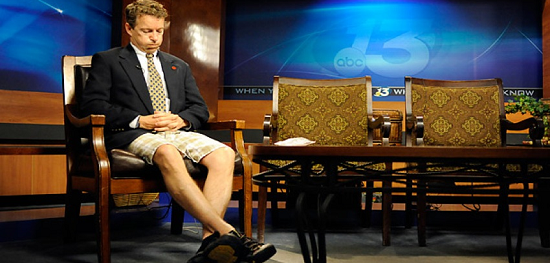 |
| Gov. Quinn struggles to meet-and-greet supporters as union members protest his policies at the 2012 Illinois State Fair. Photo courtesy of the A.P. |
There have been
twenty-two surveys
of the 2014 Illinois Governor race since Republican businessman and
challenger Bruce Rauner captured his party's nomination in March.
Governor Pat Quinn has led in only two of them, averaging 39% across all
twenty-two polls (a number that should strike fear in the heart of any
incumbent).
The Huffington Post Pollster average puts the challenger
ahead 46-44%,
and gives Rauner a 53% chance of defeating Quinn in November - again,
making it very clear that Quinn is receiving no benefit whatsoever from
the power of incumbency. In fact, from a purely polling perspective,
Quinn is one of the most vulnerable Governors and/or Senators in the
country. His job job approval rating is
awful (see
here,
here, &
here as well). Only
Tom Corbett,
Sam Brownback,
Dan Malloy, and
Mary Landrieu trail their opponents by a larger margin on Pollster.
Fortunately
for Democrats, Pat Quinn has proven himself quite resilient in the face
of awful polling and brutal political headwinds before.
Look no further than four years ago, when after a bitter contest and
razor-thin victory
in the Democratic primary, Pat Quinn was elected to his own full term
as Governor, having stepped into the role in 2009 after former Gov.
Blagojevich was famously
removed from office. His job approval ratings that year were disastrous, even on the
eve of the election.
The general election head-to-head numbers were horrendous. Of the
thirty-three publicly released polls following the Feb 2, 2010
primaries, Quinn trailed his Republican challenger in
ALL but two.
The final Pollster average in 2010 found Bill Brady (R) ahead by eight
points. The final RCP average found Brady up five points. Pollster and
Real Clear Politics even picked up on a last minute surge for Brady! They were
obviously wrong,
as Governor Quinn went on to win 47-46%. And it was arguably the
largest polling miss of the 2010 cycle (ranking right up there with the
infamously incorrectly polled Nevada Senate race between
Harry Reid and Sharon Angle).
Further
complicating things for Republican chances at picking up this
Governorship this year, the most prolific pollster to date in the Illinois race,
We Ask America, has somewhat of a problematic
track record, particularly
in Illinois.
Not to mention the fact that they make up 36% of all Illinois Governor
polls taken since the March 18th primary. To date, their results have
been highly favorable to Bruce Rauner. Out of their eight surveys taken since
the March 18 primary, Rauner has led in all of them, by as little as
three points, and as much as
fourteen.
Great news for the GOP, right? Well, not when you consider that We Ask America's
only two surveys of the 2010 Illinois Governor race found Republican
challenger Bill Brady ahead by
ten and
fifteen points, the latter of which was Brady's largest poll lead of the entire cycle.
This
isn't to pick on We Ask America. As noted above, all of the pollsters
were off in this race in 2010. Rasmussen Reports final poll on October 20, 2010
found Brady ahead of Quinn
by eight points, which also happened to be the final Pollster average.
PPP,
Fox News,
YouGov, the
Chicago Tribune,
and literally every other pollster in the final weeks of the 2010
campaign missed the mark, and none of them projected the actual winner.
So
while the Democrats are again in the position of having to defend an
unpopular Governor and unpopular President in an unfriendly political
environment, history would suggest you should not underestimate Governor
Pat Quinn. In 2010, polling that consistently favored the Republican
challenger the entire time wound up being wrong. Given that, Governor
Quinn may be the happiest (and luckiest) vulnerable incumbent running
this year.
One final note: the three most recent surveys are all good news for Gov. Quinn. The first
Chicago Tribune poll
of the cycle finds Quinn surging into an eleven point, 48-37% lead over
Rauner - easily his largest lead of both the 2014 and 2010 elections. A
Global Strategy Group poll done on behalf of the Democratic Governor
Association also finds a rare Quinn
lead of 43-40%. Finally, a nearly brand-new We Ask America survey actually finds Rauner
ahead 44-41%, but notes that the new figures represent a significant tightening from their last poll just three weeks ago when
Rauner led Quinn 46-37%.









